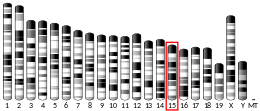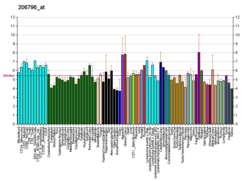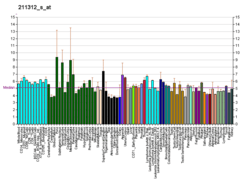WNT1-inducible-signaling pathway protein 1
WNT1-inducible-signaling pathway protein 1 (WISP-1),[5] also known as CCN4, is a matricellular protein that in humans is encoded by the WISP1 gene.[6][7]
Structure
WISP-1 is highly homologous to CYR61 (CCN1) and CTGF (CCN2), and is a member of the CCN family of secreted, extracellular matrix (ECM)-associated signaling proteins (CCN intercellular signaling protein). The CCN family of proteins shares a common molecular protein structure, characterized by an N-terminal secretory signal peptide followed by four distinct domains with homologies to insulin-like growth factor binding protein (IGFBP), von Willebrand type C repeats (vWC), thrombospondin type 1 repeat (TSR), and a cysteine knot motif within the C-terminal (CT) domain. This family of proteins regulates diverse cellular functions, including cell adhesion, migration, proliferation, differentiation, and survival.[5][8][9][10]
Role in bone development
WISP-1 promotes mesenchymal cell proliferation and osteoblastic differentiation, and represses chondrocytic differentiation.[11] WISP-1 binds BMP2 and enhances BMP2 function in osteogenesis.[12] These activities may be modulated by its direct binding to decorin and biglycan,[13] two members of a family of small leucine-rich proteoglycans present in the extracellular matrix of connective tissue.
Clinical significance
WISP-1 attenuates p53-mediated apoptosis in response to DNA damage through activation of the Akt kinase,[14] and inhibits TNF-induced cell death in cardiomyocytes.[15] Recombinant WISP-1 enhances ECM deposition in human fibroblasts, suggesting that it might play a role in matrix remodeling in vivo. WISP-1 is upregulated in human patients with idiopathic pulmonary fibrosis and in a mouse model of bleomycin-induced lung fibrosis.[16] Orotracheal application of WISP-1 neutralizing antibodies to the lung ameliorates bleomycin-induced lung fibrosis,[16] raising the possibility that WISP-1 might be a potential target for anti-fibrotic therapy.[5]
Expression of WISP-1 promotes tumor growth,[17] and high WISP-1 expression correlates with advanced tumors of the brain, breast, colon, and lung.[18][19][20][21] WISP-1 appears to inhibit metastasis[22][23] although expression of a WISP-1 splicing variant lacking the VWC domain appears to enhance the invasive characteristic of gastric carcinoma cells.[24]
References
- GRCh38: Ensembl release 89: ENSG00000104415 - Ensembl, May 2017
- GRCm38: Ensembl release 89: ENSMUSG00000005124 - Ensembl, May 2017
- "Human PubMed Reference:". National Center for Biotechnology Information, U.S. National Library of Medicine.
- "Mouse PubMed Reference:". National Center for Biotechnology Information, U.S. National Library of Medicine.
- Jun JI, Lau LF (Dec 2011). "Taking aim at the extracellular matrix: CCN proteins as emerging therapeutic targets". Nature Reviews. Drug Discovery. 10 (12): 945–63. doi:10.1038/nrd3599. PMC 3663145. PMID 22129992.
- Pennica D, Swanson TA, Welsh JW, Roy MA, Lawrence DA, Lee J, Brush J, Taneyhill LA, Deuel B, Lew M, Watanabe C, Cohen RL, Melhem MF, Finley GG, Quirke P, Goddard AD, Hillan KJ, Gurney AL, Botstein D, Levine AJ (Dec 1998). "WISP genes are members of the connective tissue growth factor family that are up-regulated in wnt-1-transformed cells and aberrantly expressed in human colon tumors". Proceedings of the National Academy of Sciences of the United States of America. 95 (25): 14717–22. doi:10.1073/pnas.95.25.14717. PMC 24515. PMID 9843955.
- "Entrez Gene: WISP1 WNT1 inducible signaling pathway protein 1".
- Chen CC, Lau LF (Apr 2009). "Functions and mechanisms of action of CCN matricellular proteins". The International Journal of Biochemistry & Cell Biology. 41 (4): 771–83. doi:10.1016/j.biocel.2008.07.025. PMC 2668982. PMID 18775791.
- Holbourn KP, Acharya KR, Perbal B (Oct 2008). "The CCN family of proteins: structure-function relationships". Trends in Biochemical Sciences. 33 (10): 461–73. doi:10.1016/j.tibs.2008.07.006. PMC 2683937. PMID 18789696.
- Leask A, Abraham DJ (Dec 2006). "All in the CCN family: essential matricellular signaling modulators emerge from the bunker". Journal of Cell Science. 119 (Pt 23): 4803–10. doi:10.1242/jcs.03270. PMID 17130294.
- French DM, Kaul RJ, D'Souza AL, Crowley CW, Bao M, Frantz GD, Filvaroff EH, Desnoyers L (Sep 2004). "WISP-1 is an osteoblastic regulator expressed during skeletal development and fracture repair". The American Journal of Pathology. 165 (3): 855–67. doi:10.1016/S0002-9440(10)63348-2. PMC 1618601. PMID 15331410.
- Ono M, Inkson CA, Kilts TM, Young MF (Jan 2011). "WISP-1/CCN4 regulates osteogenesis by enhancing BMP-2 activity". Journal of Bone and Mineral Research. 26 (1): 193–208. doi:10.1002/jbmr.205. PMC 3179320. PMID 20684029.
- Desnoyers L, Arnott D, Pennica D (Dec 2001). "WISP-1 binds to decorin and biglycan". The Journal of Biological Chemistry. 276 (50): 47599–607. doi:10.1074/jbc.M108339200. PMID 11598131.
- Su F, Overholtzer M, Besser D, Levine AJ (Jan 2002). "WISP-1 attenuates p53-mediated apoptosis in response to DNA damage through activation of the Akt kinase". Genes & Development. 16 (1): 46–57. doi:10.1101/gad.942902. PMC 155313. PMID 11782444.
- Venkatachalam K, Venkatesan B, Valente AJ, Melby PC, Nandish S, Reusch JE, Clark RA, Chandrasekar B (May 2009). "WISP1, a pro-mitogenic, pro-survival factor, mediates tumor necrosis factor-alpha (TNF-alpha)-stimulated cardiac fibroblast proliferation but inhibits TNF-alpha-induced cardiomyocyte death". The Journal of Biological Chemistry. 284 (21): 14414–27. doi:10.1074/jbc.M809757200. PMC 2682890. PMID 19339243.
- Königshoff M, Kramer M, Balsara N, Wilhelm J, Amarie OV, Jahn A, Rose F, Fink L, Seeger W, Schaefer L, Günther A, Eickelberg O (Apr 2009). "WNT1-inducible signaling protein-1 mediates pulmonary fibrosis in mice and is upregulated in humans with idiopathic pulmonary fibrosis". The Journal of Clinical Investigation. 119 (4): 772–87. doi:10.1172/JCI33950. PMC 2662540. PMID 19287097.
- Xu L, Corcoran RB, Welsh JW, Pennica D, Levine AJ (Mar 2000). "WISP-1 is a Wnt-1- and beta-catenin-responsive oncogene". Genes & Development. 14 (5): 585–95. PMC 316421. PMID 10716946.
- Kim Y, Kim KH, Lee J, Lee YA, Kim M, Lee SJ, Park K, Yang H, Jin J, Joo KM, Lee J, Nam DH (Mar 2012). "Wnt activation is implicated in glioblastoma radioresistance". Laboratory Investigation. 92 (3): 466–73. doi:10.1038/labinvest.2011.161. PMID 22083670.
- Xie D, Nakachi K, Wang H, Elashoff R, Koeffler HP (Dec 2001). "Elevated levels of connective tissue growth factor, WISP-1, and CYR61 in primary breast cancers associated with more advanced features". Cancer Research. 61 (24): 8917–23. PMID 11751417.
- Tian C, Zhou ZG, Meng WJ, Sun XF, Yu YY, Li L, Luo HZ, Yang L, Zhou B, Gu J (Jul 2007). "Overexpression of connective tissue growth factor WISP-1 in Chinese primary rectal cancer patients". World Journal of Gastroenterology. 13 (28): 3878–82. doi:10.3748/wjg.v13.i28.3878. PMC 4611224. PMID 17657846.
- Chen PP, Li WJ, Wang Y, Zhao S, Li DY, Feng LY, Shi XL, Koeffler HP, Tong XJ, Xie D (2007). "Expression of Cyr61, CTGF, and WISP-1 correlates with clinical features of lung cancer". PLOS ONE. 2 (6): e534. doi:10.1371/journal.pone.0000534. PMC 1888724. PMID 17579708.

- Hashimoto Y, Shindo-Okada N, Tani M, Nagamachi Y, Takeuchi K, Shiroishi T, Toma H, Yokota J (Feb 1998). "Expression of the Elm1 gene, a novel gene of the CCN (connective tissue growth factor, Cyr61/Cef10, and neuroblastoma overexpressed gene) family, suppresses In vivo tumor growth and metastasis of K-1735 murine melanoma cells". The Journal of Experimental Medicine. 187 (3): 289–96. doi:10.1084/jem.187.3.289. PMC 2212122. PMID 9449709.
- Soon LL, Yie TA, Shvarts A, Levine AJ, Su F, Tchou-Wong KM (Mar 2003). "Overexpression of WISP-1 down-regulated motility and invasion of lung cancer cells through inhibition of Rac activation". The Journal of Biological Chemistry. 278 (13): 11465–70. doi:10.1074/jbc.M210945200. PMID 12529380.
- Tanaka S, Sugimachi K, Saeki H, Kinoshita J, Ohga T, Shimada M, Maehara Y, Sugimachi K (Sep 2001). "A novel variant of WISP1 lacking a Von Willebrand type C module overexpressed in scirrhous gastric carcinoma". Oncogene. 20 (39): 5525–32. doi:10.1038/sj.onc.1204723. PMID 11571650.





